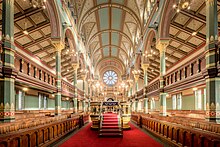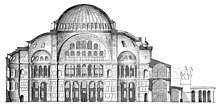Sacral architecture
The examples and perspective in this article may not represent a worldwide view of the subject. (September 2019) |

Sacral architecture (also known as sacred architecture or religious architecture) is a religious architectural practice concerned with the design and construction of places of worship or sacred or intentional space, such as churches, mosques, stupas, synagogues, and temples. Many cultures devoted considerable resources to their sacred architecture and places of worship. Religious and sacred spaces are amongst the most impressive and permanent monolithic buildings created by humanity. Conversely, sacred architecture as a locale for meta-intimacy may also be non-monolithic, ephemeral and intensely private, personal and non-public.
Sacred, religious and holy structures often evolved over centuries and were the largest buildings in the world, prior to the modern skyscraper.[citation needed] While the various styles employed in sacred architecture sometimes reflected trends in other structures, these styles also remained unique from the contemporary architecture used in other structures. With the rise of Christianity and Islam, religious buildings increasingly became centres of worship, prayer and meditation.[citation needed]

The Western scholarly discipline of the
such as signs, symbols and religious motifs are endemic to sacred architecture.Spiritual aspects of religious architecture

Sacred or religious architecture is sometimes called sacred space.
Architect Norman L. Koonce has suggested that the goal of sacred architecture is to make "transparent the boundary between matter and mind, flesh and the spirit." In discussing sacred architecture, Protestant minister Robert Schuller suggested that "to be psychologically healthy, human beings need to experience their natural setting—the setting we were designed for, which is the garden." Meanwhile, Richard Kieckhefer suggests that entering into a religious building is a metaphor for entering into spiritual relationship. Kieckhefer suggests that sacred space can be analyzed by three factors affecting spiritual process: longitudinal space emphasizes the procession and return of sacramental acts, auditorium space is suggestive of proclamation and response, and new forms of communal space designed for gathering and return depend to a great degree on minimized scale to enhance intimacy and participation in worship. The scholar of religious studies Florin George Călian affirms that "the sacred space is the place where the transcendent becomes immanent, and where the devotee can access God."[1]
Ancient architecture

Sacred architecture spans a number of ancient architectural styles including
Classical architecture

Around 600 BCE the wooden columns of the Temple of Hera at Olympia were replaced by stone columns. With the spread of this process to other sanctuary structures a few stone buildings have survived through the ages. Since temples are the only buildings which survive in numbers, most of our concept of classical architecture is based on religious structures. The Parthenon, which served as a treasury building as well as a place for veneration of deity, is widely regarded as the greatest example of classical architecture.
Dharmic religion architecture
Buddhism

The initial function of the stupa was the veneration and safe-guarding of the relics of the
The pagoda is an evolution of the Indian stupa that is marked by a tiered tower with multiple eaves common in China, Japan, Korea, Nepal and other parts of Asia. Buddhist temples were developed rather later and outside South Asia, where Buddhism gradually declined from the early centuries CE onwards, though an early example is that of the Mahabodhi Temple at Bodh Gaya in Bihar. The architectural structure of the stupa spread across Asia, taking on many diverse forms as details specific to different regions were incorporated into the overall design. It was spread to China and the Asian region by Araniko, a Nepali architect in the early 13th century for Kublai Khan.
Hinduism
Christian architecture
Byzantine architecture

Byzantine architecture evolved from Roman architecture. Eventually, a style emerged incorporating Near East influences and the Greek cross plan for church design. In addition, brick replaced stone, classical order was less strictly observed, mosaics replaced carved decoration, and complex domes were erected.
One of the great breakthroughs in the history of Western architecture occurred when Justinian I's architects invented a complex system providing for a smooth transition from a square plan of the church to a circular dome (or domes) by means of squinches or pendentives. The prime example of early Byzantine religious architecture is the Hagia Sophia in Istanbul.
European medieval architecture

The religious architecture of Christian churches in the
.Gothic architecture

Renaissance architecture

The
Baroque architecture

Evolving from
Mormon temples

Modern and post-modern architectures

Shaker communities
Shaker communities were semiotically architectured upon the crux of the compass rose.[citation needed]
Islam
Early Islamic architecture

Byzantine architecture had a great influence on early
Ottoman architecture
The Ottomans introduced 'central dome' mosques in the 15th century that have a large dome centered over the prayer hall. In addition to having one large dome at the center, there are often smaller domes that exist off-center over the prayer hall or throughout the rest of the mosque, in areas where prayer is not performed.[6] The Dome of the Rock mosque in Jerusalem is perhaps the best known example of a central dome mosque.

Iranian sacral architecture
'Iwan mosques' are most notable for their domed chambers and
Characteristic features and styles
A common feature in mosques is the

Domes have been a hallmark of
The prayer hall, also known as the
Usually opposite the entrance to the prayer hall is the qibla wall, which is the visually emphasized area inside the prayer hall. The qibla wall is normally set perpendicular to a line leading to Mecca.[10] Worshippers pray in rows parallel to the qibla wall and thus arrange themselves so they face Mecca. In the qibla wall, usually at its center, is the mihrab, a niche or depression indicating the'qibla wall. Usually the mihrab is not occupied by furniture either. Sometimes, especially during Friday prayers, a raised minbar or pulpit is located to the side of the mihrab for a khatib or some other speaker to offer a sermon (khutbah). The mihrab serves as the location where the imam leads the five daily prayers on a regular basis.[11]
Mosques often have ablution fountains or other facilities for washing in their entryways or courtyards. However, worshippers at much smaller mosques often have to use restrooms to perform their ablutions. In traditional mosques, this function is often elaborated into a freestanding building in the center of a courtyard.[5] Modern mosques may have a variety of amenities available to their congregants and the community, such as health clinics, libraries and gymnasiums.
Bahá'í Houses of Worship
-
The Baháʼí Lotus Temple in Delhi, India
See also
- Chapel
- Ġgantija
- Mandir
- Hierotopy
- Sanctum sanctorum
- Sacred site
Notes
- S2CID 238206022.
- ^ Andrzej Piotrowski (2011), Architecture of Thought, U of Minnesota Press, p. 23
- ISBN 0-89870-631-9.
- ^ ISSN 1573-3912.
- ^ a b "Religious Architecture and Islamic Cultures". Massachusetts Institute of Technology. Retrieved 2006-04-09.
- ^ a b "Vocabulary of Islamic Architecture". Massachusetts Institute of Technology. Archived from the original on 2005-11-24. Retrieved 2006-04-09.
- ^ Hillenbrand, R. "Manara, Manar". In P.J. Bearman; Th. Bianquis; C.E. Bosworth; E. van Donzel; W.P. Heinrichs (eds.). Encyclopaedia of Islam Online. Brill Academic Publishers.
- ^ Asher, Catherine B. (1992-09-24). "Aurangzeb and the Islamization of the Mughal style". Architecture of Mughal India. Cambridge University Press. p. 256.
- ^ "Mosque FAQ". The University of Tulsa. Archived from the original on December 30, 2004. Retrieved 2006-04-09.
- ^ Bierman, Irene A. (1998-12-16). Writing Signs: Fatimid Public Text. University of California Press. p. 150.
- ^ "Terms 1: Mosque". University of Tokyo Institute of Oriental Culture. Retrieved 2006-04-09.
- ^ "Houses of Worship | Bahá'í World News Service (BWNS)". Bahá’í World News Service. Retrieved 2021-08-17.
- ^ "Houses of Worship | Bahá'í World News Service (BWNS)". Bahá’í World News Service. Retrieved 2021-08-17.
- ^ "Sacred Baha'i Architecture". bahai-library.com. Retrieved 2021-08-17.
- ^ "Houses of Worship | Bahá'í World News Service (BWNS)". Bahá’í World News Service. Retrieved 2021-08-17.
References
- Jeanne Halgren Kilde, When Church Became Theatre: The Transformation of Evangelical Church Architecture and Worship in Nineteenth-Century America. (Oxford University Press:2002). ISBN
- Michael E. DeSanctis, Building from Belief: Advance, Retreat, and Compromise in the Remaking of Catholic Church Architecture.. (Liturgical Press:2002). ISBN
- Richard Kieckhefer, Theology in Stone: Church Architecture from Byzantium to Berkeley. (Oxford University Press, USA: 2004). ISBN
- Anne C. Loveland and Otis B. Wheeler, From Meetinghouse to Megachurch: A Material and Cultural History. (University of Missouri Press:2003). ISBN
- Michael S. Rose, Ugly as Sin: Why They Changed Our Churches from Sacred Places to Meeting Spaces -- and How We Can Change Them Back Again. (Sophia Institute Press: 2001). ISBN
- ISBN 0-89870-631-9.
- R. Kevin Seasoltz, A Sense Of The Sacred: Theological Foundations Of Christian Architecture And Art. (Continuum International Publishing Group: 2005) ISBN
Further reading
- Bain, George. Celtic Art: The Methods of Construction. Dover, 1973. ISBN 0-486-22923-8.
- Bamford, Christopher. Homage to Pythagoras: Rediscovering Sacred Science, Lindisfarne Press, 1994, ISBN 0-940262-63-0.
- Calian, George. Sacred Spaces in Motion, RES, 2021, ISSN 2359-8107.
- Critchlow, Keith (1970). Order In Space: A Design Source Book. Viking..
- Critchlow, Keith (1976). Islamic Patterns: An Analytical and Cosmological Approach. Schocken Books. ISBN 0-8052-3627-9.
- Hill, Marsha (2007). Gifts for the gods: images from Egyptian temples. New York: The Metropolitan Museum of Art. ISBN 9781588392312..
- ISBN 0-933999-72-0..
- Johnson, Anthony: Solving Stonehenge, the New Key to an Ancient Enigma. Thames & Hudson 2008 ISBN 978-0-500-05155-9.
- ISBN 0-500-81030-3.
- Lesser, George (1957–1964). Gothic cathedrals and sacred geometry. London: A. Tiranti..
- Lippard, Lucy R.: Overlay: Contemporary Art and the Art of Prehistory. Pantheon Books New York 1983 ISBN 0-394-51812-8.
- ISBN 0-349-12320-9.
- ISBN 0-89870-631-9.
- ISBN 0-88010-472-4..
- Schneider, Michael S.: A Beginner's Guide to Constructing the Universe: Mathematical Archetypes of Nature, Art, and Science. Harper Paperbacks, 1995. ISBN 0-06-092671-6.
- Pennick, Nigel: Beginnings: Geomancy, Builders' Rites and Electional Astrology in the European Tradition .
- Pennick, Nigel: Sacred Geometry: Symbolism and Purpose in Religious Structures.
- Pennick, Nigel: The Ancient Science of Geomancy: Living in Harmony with the Earth.
- Pennick, Nigel: The Sacred Art of Geometry: Temples of the Phoenix.
- Pennick, Nigel: The Oracle of Geomancy.
- Pennick, Nigel: The Ancient Science of Geomancy: Man in Harmony with the Earth.
- West, John Anthony, Inaugural Lines: Sacred geometry at St. John the Divine, Parabola magazine, v.8, n.1, Spring 1983.
External links
- Interfaith Forum on Religion, Art and Architecture American Institute of Architects
- Architecture, Culture & Spirituality
- Sacred Architecture online journal



